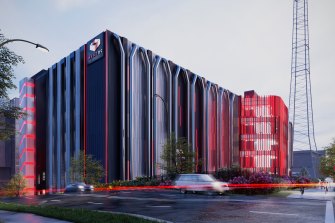Data centres are specialised facilities used to house information technology and communications
equipment, including servers, storage devices and routers.
Data centres are a niche segment of the broader industrial and logistics sector and differ from traditional industrial buildings because of their complex technical specifications and fit-out requirements.
The key technical factors for the sector include the availability of cloud operations, power and fibre network cable connectivity, land costs and government policies.
Home-grown operator NextDC and the Macquarie-backed AirTrunk have escalated their property expansion plans in the past year as has the industrial infrastructure development firm LOGOS, which recently partnered with Pure Data Centres (Pure DC) to expand its critical data centre infrastructure portfolio across the Asia Pacific region.
In its latest deal, NextDC has an option over a 12.4ha site in Sydney’s Horsley Park, worth about $124 million.
In Melbourne, it bought an additional 4 hectares of land neighbouring its new M3 West Footscray data centre, currently under construction for $24 million through Colliers’ Hugh Gilbert and Charlie Woodley. This will bring the total site to around 10 hectares and, on completion, will see the site home to a 150MW hyperscale facility including a customer operation and administration centre.
Craig Scroggie, chief executive of NextDC said data, as the world’s most valuable commodity, is playing a core role at the heart of commerce, government and community.
“Its rise is best demonstrated by the outstanding success of companies like Amazon, Netflix, Google, Microsoft, Apple and Atlassian, that will all require safe storage,” he said.
Hamish Tadgell, portfolio manager of the SGH High Conviction Fund and Grant Berry, the A-REIT manager have identified the sector for growth and have invested in NextDC.
“It will be a growth area undoubtedly. We are moving more and more digital, and that will mean more and more need for data,” Mr Berry said.
“What we want our current and potential investors to understand is that there is big growth in cloud technology.”
Josh Griggs, Trifalga DC
Mr Tadgell added that given the time needed to construct the tech-intensive sites and internal fit-outs there is a “massive capital investment upfront required” as they typically take a couple of years to build.
“And that means it has a different risk profile,” Mr Tadgell said.
In another deal Trifalga DC has partnered with First Nations operator Kalinda IT on a data centre rollout. Trifalga will provide the investment, deploying the capital and infrastructure for each site, while Kalinda IT, a certified Supply Nation member, will provide tech services to manage, run and sell services within each asset.
Trifalga DC’s first data centre project, a 74,000 square metre facility at Rouse Hill in Sydney’s west, has already received development approval. General manager Josh Griggs said data centres were an innovative asset class that would provide new opportunities to investors who are interested in big growth.
“Investors understand big growth and what we want our current and potential investors to understand is that there is big growth in cloud technology,” he said.
Tanya Parker, Colliers’ national director valuation and advisory services, says across the Asia Pacific region, investment volumes had increased exponentially over the past two years, with $4.5 billion recorded in 2020 and $3.8 billion already in the first nine months of 2021.
“By comparison, annual investment volumes averaged $1.2 billion between 2015 and 2019,” Ms Parker said.
Centuria Industrial fund has also made a large commitment in 2020 paying $416 million for the Telstra for its Clayton, Melbourne data centre, with a long-term lease back arrangement for the telco. Head of funds management Ross Lees said the demand for data centres accelerated as more people worked and shopped from home during the coronavirus pandemic.
Lendlease has joined the rush after it established a data centres fund a couple of years ago with an overseas sovereign wealth fund and the first project will be an $800 million hyperscale data centre in greater Tokyo covering more than 60,000 square metres.

A renders of the NEXTDC S3 data centre in Artarmon on Sydney’s lower North Shore, with Multiplex to deliver stage 1.Credit:
The giant Microsoft is also embarking on expansion plans for campus-style properties across the country, said to be worth up to $1.3 billion. Airtrunk’s planned SYD3 facility at Blacktown will be 320 MW at full capacity.
Colliers national director of industrial in Sydney, David Hall, said the main theme was that Australia was becoming a global hub for data centre facilities.
He said the country was well suited to the industry as there was secure access to power, available land located near CBDs and Sydney was a major landing port for submarine communication cables that linked directly to Asia and the United States.
“Currently, Sydney provides an estimated 430 megawatts (MW) of third-party data centre capacity, with a further 1200 MW in the pipeline,” Mr Hall said
Loading
The firm’s Melbourne-based national director industrial, Mr High Gilbert, said data centre operators had done more transactions in the past two years than they in the history of the Melbourne market.
“Melbourne is particularly suited to data centre facilities given the cooler-than-average outside ambient temperatures. Cooling is a critical factor in data centre operation, which requires significant air conditioning investment to keep the servers in a controlled cool environment,” Mr Gilbert said.








